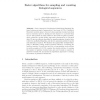401 search results - page 5 / 81 » Generalizations of Markov model to characterize biological s... |
BMCBI
2005
14 years 11 months ago
2005
Background: Probabilistic models for sequence comparison (such as hidden Markov models and pair hidden Markov models for proteins and mRNAs, or their context-free grammar counterp...
BMCBI
2008
14 years 11 months ago
2008
Background: Biologically active sequence motifs often have positional preferences with respect to a genomic landmark. For example, many known transcription factor binding sites (T...
113
click to vote
ISAMI
2010
14 years 9 months ago
2010
Probabilistic models of languages are fundamental to understand and learn the profile of the subjacent code in order to estimate its entropy, enabling the verification and predicti...
ISMB
1997
15 years 1 months ago
1997
Protein chimerism is a phenomenon involving the combination of multiple ancestral sequences into a single, multi-domain protein through evolution. We propose a novel method for de...
SPIRE
2009
Springer
15 years 4 months ago
2009
Springer
Abstract. A set of sequences S is pairwise bounded if the Hamming distance between any pair of sequences in S is at most 2d. The Consensus Sequence problem aims to discern between ...

